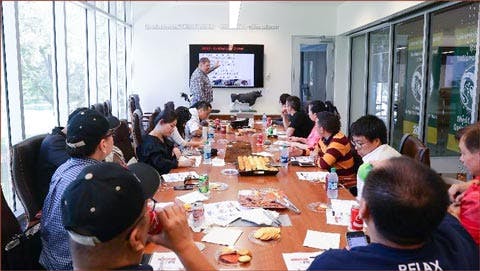Chinese Chefs, Journalists Gain Insight into U.S. Beef Industry
A team of Chinese chefs and media representatives got a close look at the U.S. beef industry on a tour that included visits to ranches, slaughter plants, retail outlets, restaurants and a university research facility aimed at improving beef quality. Funded by the Beef Checkoff Program, the tour was designed to educate decision makers in China’s foodservice industry following the market’s recent reopening to U.S. beef.

A team of Chinese chefs and media representatives participated in a U.S. beef cooking workshop organized by USMEF
A stop at One World Beef’s slaughter facility in California impressed the team, said Ming Liang, USMEF marketing director in China.
“We showed the chefs how U.S. beef is slaughtered and how the different cuts of meat are broken out and selected,” said Liang. “The president of One World Beef accompanied the team to the plant and explained every step the company takes – from slaughter, inspection, grading and cutting to packing and storage – so the chefs were able to get a better understanding of what the U.S. beef industry does to maintain consistent quality and what is done to make sure every piece of U.S. beef is safe.”
To sample the end product, members of the Chinese delegation attended a food tour in Los Angeles, visiting three restaurants that feature high-quality U.S. beef, along with a traditional butcher shop. Restaurant owners were interviewed by media members on modern American food trends and cooking styles and to share information about the many uses for U.S. beef on their menus. The restaurants visited were:
- The Curious Palate: A farm-to-table restaurant with locally sourced meat and ingredients. The tastings included U.S. beef spicy short rib ragu tagliatelle and pastrami sandwiches.
- Meat On Ocean: A steakhouse that has many different cuts of high-quality beef and charcuterie on its menu. The media team toured its butcher shop and discussed menu options with the executive chef.
- Maple Block Meat Company: This restaurant’s U.S. beef brisket has been voted “best brisket” in California.

At One World Beef, the China team learned about U.S. beef slaughter and packing

On a visit to Colorado State University, Chinese chefs and media representatives saw a variety of research projects designed to help improve beef quality
“By visiting traditional, fusion and trendy restaurants, the Chinese chefs were exposed to a lot of new and creative ideas for U.S. beef,” said Liang. “The chefs were able to look at how each type of restaurant operates and how they build their menus. They can now decide what will work in China and what may not. Either way, they were able to see how U.S. beef can be implemented on their own menus and in their businesses.”
The team then visited the Colorado State University (CSU) Department of Animal Sciences research farm, which includes cow-calf, feeder cattle and finished cattle operations.
“We were able to show the chef team the feed the university is using – things like fermented corn stalk and ground corn – and we showed them examples of the various research projects aimed at improving cattle genetics and overall meat quality,” said Liang.
While at CSU, the team also took the course “Meeting Consumer Expectations: USDA Grades of Beef,” which introduced topics such as cattle inventory, beef production volume, breed differences, beef grading and different branded programs.
“The course helped the chefs gain a better understanding of beef price trends, as well as grading and the consumer eating experience in the U.S.,” said Liang. “We also did some tasting experiments, such as eating different grades of the same cut and eating the same cuts cooking at different degrees – well done, medium rare, etc. – to give them a full eating experience.”
Other stops on the team’s tour included:
- A stir cooking school was conducted, introducing the team to the use of alternative cuts of U.S. beef to create dishes. An instructor introduced the chefs to beef skewers and beef pasta using chuck and sirloin.
- At Coyote Ridge Ranch in Colorado, the team was served a traditional western-style lunch. Ranch managers explained how they breed, feed and raise cattle.
- Retail visits in Denver included stops at Marczyk Fine Foods and Tony’s Meats, to see U.S. beef and pork on retail display and how to merchandise U.S. beef and pork in supermarkets.
- The team had lunch with Greg Bloom, executive director of the Colorado Beef Council, at the Highland Tap and Burger restaurant in Denver, where the chefs tasted five kinds of U.S. beef, pork and lamb burgers.
- The team dined at the Denver location of The Palm, a fine-dining chain steakhouse. With some of the chefs already operating chain restaurants in China, they were able to get ideas on how to manage an upscale chain steak house.
